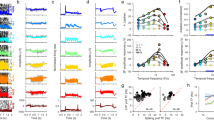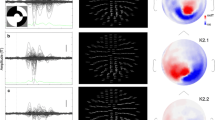Abstract
Nonlinear interactions in the human visual system were studied using visual evoked potentials (VEPs). In one experiment (superimposed condition), all segments of a dartboard pattern were contrast reversed in time by a sum of two sinusoidal signals. In a second experiment (lateral condition), segments in some regions of the dartboard pattern were contrast reversed by a single sinusoid of one frequency, while segments in other (contiguous) regions of the pattern were contrast reversed by a single sinusoid of another frequency. An identical set of ten frequency pairs was used in each experiment. The frequency pairs were chosen such that the difference between frequencies in each pair was 2 Hz. Amplitudes and phases of the sum and difference frequency components of the VEP (intermodulation terms) were retrieved by Fourier analysis and served as measures of nonlinear interactions. The use of input pairs with a fixed separation in frequency enabled the estimation of the temporal characteristics of the visual pathways prior to a second linear stage. The use of superimposed and lateral conditions revealed antagonistic contributions to the VEP, possibly reflecting direct-through excitatory and lateral inhibitory pathways, respectively.
Similar content being viewed by others
References
Clynes, M.: Unidirectional rate sensitivity: a biocybernetic law of reflex and humoral systems as physiologic channels of control and communication. Ann. N.Y. Acad. Sci. 92, 946–969 (1961)
Clynes, M.: Dynamics and spatial behavior of light evoked potentials, their modification under hypnosis, and on-line correlation in relation to rhythmic components. Ann. N.Y. Acad. Sci. 112, 468–508 (1964)
Creutzfeldt, O.D., Kuhnt, U.: Electrophysiology and topographical distribution of visual evoked potentials in animals. In: Handbook of sensory physiology. Vol. VII/3, pp. 595–646 Jung, R., ed. Berlin, Heidelberg, New York: Springer 1973
Hartline, H.K., Ratliff, F.: Inhibitory interaction of receptor units in the eye of Limulus. J. Gen. Physiol. 40, 357–376 (1957)
Hess, R., Negishi, K., Creutzfeldt, O.: The horizontal spread of intracortical inhibition in the visual cortex. Exp. Brain Res. 22, 415–419 (1975)
Jasper, H.H.: Report of a committee on methods of clinical examination in electroencephalography. Electroenceph. Clin. Neurophysiol. 10, 370–375 (1958)
Mikman, N., Schick, G., Rossetto, M., Ratliff, F., Shapley, R., Victor, J.: A two-dimensional computer-controlled visual stimulator. Behav. Res. Meth. Instrum. 12, 283–292 (1980)
Ratliff, F., Victor, J.D., Shapley, R.M.: Nonlinear analysis of visual evoked potentials in the human. J. Opt. Soc. Am. 68, 1427 (1978)
Ratliff, F., Zemon, V.: Some new methods for the analysis of lateral interactions that influence the visual evoked potential. Ann. N.Y. Acad. Sci. 388, 113–124 (1982)
Ratliff, F., Zemon, V.: Visual evoked potentials elicited in normal subjects and in epileptic patients by windmill-dartboard stimuli (in press, 1984)
Spekreijse, H., Oosting, H.: Linearizing: A method for analysing and synthesizing nonlinear systems. Kybernetik 7, 22–31 (1970)
Spekreijse, H., Reits, D.: Sequential analysis of the visual evoked potential system in man; nonlinear analysis of a sandwich system. Ann. N.Y. Acad. Sci. 383, 72–97 (1982)
Tyler, C.W., Apkarian, P., Nakayama, K.: Multiple spatialfrequency tuning of electrical responses from human visual cortex. Exp. Brain Res. 33, 535–550 (1978)
Victor, J.D., Knight, B.W.: Nonlinear analysis with an arbitrary stimulus ensemble. Q. Appl. Math. 37, 113–136 (1979)
Victor, J.D., Shapley, R.: A method of nonlinear analysis in the frequency domain. Biophys. J. 29, 459–483 (1980)
Watanabe, S., Konishi, M., Creutzfeldt, O.D.: Postsynaptic potentials in the cat's visual cortex following electrical stimulation of afferent pathways. Exp. Brain Res. 1, 272–283 (1966)
Zemon, V., Kaplan, E., Ratliff, F.: Bicuculline enhances a negative component and diminishes a positive component of the visual evoked cortical potential in the cat. Proc. NAS USA 77, 7476–7478 (1980)
Zemon, V., Ratliff, F.: Intermodulation responses in the visual evoked potential. J. Opt. Soc. Am. 71, 1617 (1981)
Zemon, V., Ratliff, R.: Intermodulation components of visual evoked potentials. The Second International Evoked Potentials Symposium, Cleveland, Ohio, 2, 143 (1982a)
Zemon, V., Ratliff, F.: Visual evoked potentials: evidence for lateral interactions. Proc. NAS USA 79, 5723–5726 (1982b)
Author information
Authors and Affiliations
Additional information
Supported by grants from the U.S. National Eye Institute, the Esther A. and Joseph Klingenstein Fund, and the Harry Frank Guggenheim Foundation
Rights and permissions
About this article
Cite this article
Zemon, V., Ratliff, F. Intermodulation components of the visual evoked potential: Responses to lateral and superimposed stimuli. Biol. Cybern. 50, 401–408 (1984). https://doi.org/10.1007/BF00335197
Received:
Issue Date:
DOI: https://doi.org/10.1007/BF00335197




